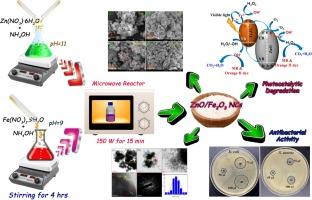In-situ treated ZnO/Fe2O3 nanocomposites synthesized via microwave for enhanced Photo-Fenton photocatalysis and antimicrobial efficacy
IF 3.9
3区 材料科学
Q2 MATERIALS SCIENCE, MULTIDISCIPLINARY
引用次数: 0
Abstract
The development of effective and cost-efficient photocatalysts is crucial for wastewater treatment. This study aimed to synthesize and evaluate ZnO/Fe2O3 nanocomposites (ZnFe NCs) as novel photocatalysts for the removal of organic contaminates. We synthesized ZnFe NCs using a simple, environmentally friendly microwave-assisted method. Characterization was conducted using HR-TEM, SEM-EDS, XPS, and X-ray diffraction. The photocatalytic performance was evaluated with methylene blue (MB) and orange II (O-II) dyes, showing that ZnFe NCs with H2O2 achieved 98.2 % dye removal under 120 min of sunlight. This performance surpassed that of controls, including ZnO, Fe2O3, and ZnO/Fe2O3 alone. The study also determined optimal conditions for the photocatalysts, demonstrating enhanced photocatalytic activity. Antibacterial tests showed inhibition zones of 22 mm against Staphylococcus aureus (S. aureus) and 20 mm against Escherichia coli (E. coli) at 100 mg/mL. ZnFe NCs show dual potential for photocatalytic degradation and antimicrobial activity, ideal for wastewater treatment and microbial control.

通过微波原位处理合成的 ZnO/Fe2O3 纳米复合材料可增强光-芬顿光催化和抗菌功效
开发有效且具有成本效益的光催化剂对废水处理至关重要。本研究旨在合成和评估 ZnO/Fe2O3 纳米复合材料(ZnFe NCs)作为新型光催化剂去除有机污染物的效果。我们采用一种简单、环保的微波辅助方法合成了 ZnFe NCs。利用 HR-TEM、SEM-EDS、XPS 和 X 射线衍射进行了表征。利用亚甲基蓝(MB)和橙 II(O-II)染料对其光催化性能进行了评估,结果表明,在阳光照射 120 分钟后,含有 H2O2 的 ZnFe NCs 对染料的去除率达到 98.2%。这一性能超过了包括氧化锌、Fe2O3 和氧化锌/Fe2O3 本身在内的对照组。研究还确定了光催化剂的最佳条件,证明光催化活性得到了增强。抗菌测试表明,在 100 毫克/毫升的浓度下,对金黄色葡萄球菌(S. aureus)的抑制区为 22 毫米,对大肠杆菌(E. coli)的抑制区为 20 毫米。ZnFe NCs 具有光催化降解和抗菌的双重潜力,是废水处理和微生物控制的理想选择。
本文章由计算机程序翻译,如有差异,请以英文原文为准。
求助全文
约1分钟内获得全文
求助全文
来源期刊

Materials Science and Engineering: B
工程技术-材料科学:综合
CiteScore
5.60
自引率
2.80%
发文量
481
审稿时长
3.5 months
期刊介绍:
The journal provides an international medium for the publication of theoretical and experimental studies and reviews related to the electronic, electrochemical, ionic, magnetic, optical, and biosensing properties of solid state materials in bulk, thin film and particulate forms. Papers dealing with synthesis, processing, characterization, structure, physical properties and computational aspects of nano-crystalline, crystalline, amorphous and glassy forms of ceramics, semiconductors, layered insertion compounds, low-dimensional compounds and systems, fast-ion conductors, polymers and dielectrics are viewed as suitable for publication. Articles focused on nano-structured aspects of these advanced solid-state materials will also be considered suitable.
 求助内容:
求助内容: 应助结果提醒方式:
应助结果提醒方式:


